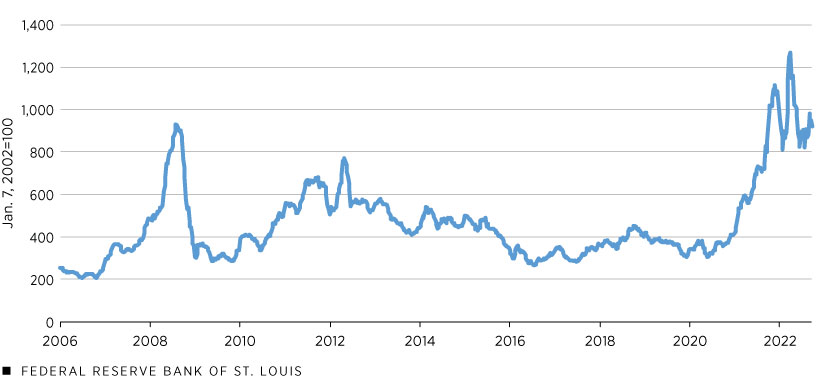The Russia-Ukraine War’s Impact on Fertilizer Prices in 2022
After Russia invaded Ukraine in February 2022, the price of fertilizer reached record highs in the spring of that year. What were the factors that created this situation?
In an October 2022 Regional Economist article, St. Louis Fed Senior Policy Analyst Suzanne Jenkins examined prices in the global fertilizer market, in which Russia is the world’s top fertilizer exporter, and their impact on U.S. farmers.
She noted that even before the invasion, fertilizer supplies were already tight as a result of COVID-19 pandemic-related disruptions in production. This situation was exacerbated when the international community imposed economic sanctions against Russia, spurring that country to restrict exports of its fertilizer.
“In addition, shipping companies, as well as Western financing and vessel insurance companies, steered away from Russia amid international financial sanctions and safety concerns,” the author wrote. “The result was that global and U.S. fertilizer prices surged to record levels in March 2022.”
Prices Reached Record Levels
Citing the World Bank, Jenkins noted that world fertilizer prices increased 30% by early 2022 after experiencing an 80% hike in 2021.
As shown in the following figure, Bloomberg’s Green Markets Weekly North America Fertilizer Price Index hit an all-time high of 1,270.4 on March 25, 2022, surpassing the previous record of 932.3 set in 2008. (The index is based on the benchmark prices of three fertilizer ingredients: nitrogen, phosphorus and potassium.)
Green Markets Weekly North America Fertilizer Price Index,
January 2006-September 2022

SOURCES: Green Markets, FertilizerPricing.com. ©Bloomberg LP.
NOTES: The Green Markets Weekly North America Fertilizer Price Index uses the U.S. Gulf Coast urea, U.S. Corn Belt potash and New Orleans (NOLA) barge diammonium phosphate (DAP) benchmark prices and is value-weighted based on annual global demand for each nutrient. Figure data are from Jan. 2, 2006, to Sept. 23, 2022.
On average, fertilizer use in the U.S. makes up 36% of operating costs of growing corn, 35% of wheat and 10% of soybeans, the author pointed out.
The Russia-Ukraine war has also disrupted the flow of natural gas—a key input used in nitrogen production—to Europe, she added, noting that surging gas prices caused at least 10 of Europe’s fertilizer plants to shutter or decrease output in July 2022 alone.
Actions That Eased Tight Supplies
Several developments during the summer of 2022 eased the tight supply and caused fertilizer prices to fall, Jenkins noted. The U.S. International Trade Commission rejected substantial antidumping and countervailing duties on certain fertilizer imports from Russia and Trinidad and Tobago in July 2022, while Russia and Ukraine reached deals in that same month that allowed Ukraine to resume exporting grain and other agriculture products and ensured Russian food and fertilizer would have access to global markets.
The 2022 price shock brought about changes to the way U.S. farmers do business. Fertilizer suppliers were increasingly shifting to just-in-time pricing, and farmers and their suppliers were also moving away from verbal agreements to more formalized contracts, Jenkins observed.
“Meanwhile, the fertilizer price shock has sparked interest in high-tech precision-application tools and equipment that reduce the amount of fertilizer needed, as well as in biotech solutions such as nitrogen-producing microbes that can add nutrients to soil without the need for natural gas during production,” she wrote.
Citation
ldquoThe Russia-Ukraine War’s Impact on Fertilizer Prices in 2022,rdquo St. Louis Fed On the Economy, April 4, 2023.
This blog offers commentary, analysis and data from our economists and experts. Views expressed are not necessarily those of the St. Louis Fed or Federal Reserve System.
Email Us
All other blog-related questions

